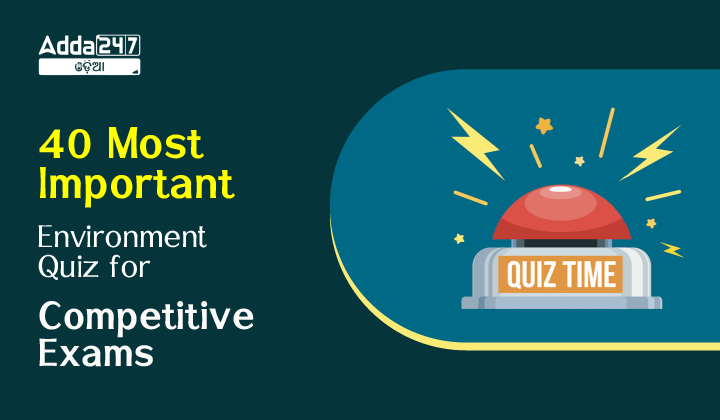The Environment Quiz for Competitive Exams is a vital component of assessing candidates’ knowledge and awareness about environmental issues. This quiz aims to test individuals on topics such as climate change, pollution, biodiversity, and sustainable development. It covers various aspects of the environment, including renewable energy, waste management, and conservation strategies. Questions may range from identifying endangered species to understanding the impacts of deforestation. The quiz not only evaluates the candidates’ understanding of environmental concepts but also promotes awareness and encourages responsible behavior toward the environment. By including this quiz in competitive exams, it emphasizes the significance of environmental literacy and inspires individuals to become environmentally conscious citizens.
Q1.Which one of the following is an important strategy for the conservation of biodiversity?
(A) Wild Life Sanctuaries
(B) National Parks
(C) Botanical Gardens
(D) Biosphere Reserves
S1. Ans.(D) Biosphere Reserves
Q2.Which one of the following trees is considered to be an environmental hazard?
(A) Eucalyptus
(B) Babool
(C) Neem
(D) Amaltas
S2. Ans.(A) Eucalyptus
Q3.The greenhouse effect is mostly caused by
(A) Ozone layer
(B) Moisture in the atmosphere
(C) Infra-red radiation
(D) Carbon dioxide in the atmosphere
S3. Ans. (D) Carbon dioxide in the atmosphere
Q4.Which one of the following adopted “Agenda 21”?
(A) Kyoto Protocol
(B) Montreal Protocol
(C) Summit on Sustainable Development
(D) First Earth Summit
S4. Ans.(D) First Earth Summit
Q5.Which of the following is not a greenhouse gas?
(A) Nitrogen
(B) Methane
(C) Nitrous oxide
(D) Carbon dioxide
S5. Ans.(A) Nitrogen
Q6.Which one of the following is the best source of generating electricity in India from the viewpoint of sustainable development?
(A) Atomic energy
(B) Coal
(C) Mineral oil and gas
(D) Hydroelectricity
S6. Ans.(D) Hydro electricity
Q7.The use of fossil fuels is responsible for the increase in the amount of which gas in the atmosphere?
(A) Argon
(B) Carbon dioxide
(C) Ozone
(D) Nitrogen
S7. Ans.(B) Carbon dioxide
Q8.The Ramsar Convention is associated with the conservation of
(A) Wet lands
(B) Drylands
(C) Forests
(D) Biofuels
S8. Ans.(A) Wet lands
Q9.The greatest diversity of animal and plant species occurs in
(A) Equatorial forests
(B) Deserts and Savanna
(C) Temperature deciduous forests
(D) Tropical moist forests
S9. Ans.(A) Equatorial forests
Q10.In a food chain, the solar energy utilized by plants is only
(A) 1.0%
(B) 10%
(C) 0.01%
(D) 0.1%
S10. Ans.(A) 1.0%
Q11.The transitional zone between two distinct communities is known as
(A) Ecotone
(B) Ecotype
(C) Ecade
(D) Ecosphere
S11. Ans.(A) Ecotone
Q12.Which one among the following is not an endangered bird in India?
(A) Forest Owlet
(B) Mallard
(C) Great Indian Bustard
(D) White-bellied Heron
S12. Ans.(B) Mallard
Q13.Chipko movement was basically against
(A) Cultural pollution
(B) Deforestation
(C) Noise pollution
(D) Water pollution
S13. Ans.(B) Deforestation
Q14.Global-500 Award is given for achievement in the field of
(A) Population control
(B) Movement against terrorism
(C) Movement against narcotics
(D) Environmental protection
S14. Ans.(D) Environmental protection
Q15.The loss of biodiversity is due to
(A) Destruction of forests
(B) Environmental pollution
(C) The destruction of natural baits of the organism
(D) All of the above
S15. Ans.(D) All of the above
Q16.In an ecosystem, a stable group is called
(A) Succession
(B) Seral
(C) Climax
(D) Ecotone
S16. Ans.(D) Ecotone
Q17.Which of the following is not helpful in maintaining ecological stability?
(A) Ecosystem diversity
(B) Homeostatic mechanism
(C) Ecosystem complexity
(D) Ecosystem uniformity
S17. Ans.(D) Ecosystem uniformity
Q18.Which of the following is not a water pollutant?
(A) Sulphur dioxide
(B) Zinc
(C) Copper
(D) Nickel
S18. Ans.(C) Coppe
Q19.Acid rain is caused due to air pollution by
(A) Nitrous oxide and sulphur dioxide
(B) Carbon dioxide
(C) Carbon monoxide
(D) Methane
S19. Ans. (A) Nitrous oxide and sulphur dioxide
Q20.Which of the following components of the ecosystem acts as an intermediatory between biotic and abiotic components?
(A) Habitat
(B) Decomposer
(C) Consumer
(D) Producer
S20. Ans.(D) Producer
Q21.What term denotes the organisms getting their food from others?
(A) Autotrophs
(B) Heterotrophs
(C) Synthesizers
(D) Producers
S21. Ans.(B) Heterotrophs
Q22.The Ozone layer restricts
(A) Ultraviolet radiation
(B) X-rays and Gamma rays
(C) Infrared radiation
(D) Visible light
S22. Ans.(A) Ultraviolet radiation
Q23.Among the biotic components of the ecosystem, the producer system is
(A) Green plants
(B) Tiger
(C) Cow
(D) Peacock
S23. Ans.(A) Green plants
Q24.The maximum biodiversity is found in
(A) Arctic forests
(B) Tropical rainforests
(C) Temperate forests
(D) Coniferous forests
S24. Ans.(B) Tropical rain forests
Q25.Which of the following is designated as the “lungs of the world”?
(A) Equatorial evergreen forests
(B) Taiga forests
(C) Mid-latitudes mixed forests
(D) Mangrove forests
S25. Ans.(A) Equatorial evergreen forests
Q26.Global warming is caused due to the emission of
(A) Hydrocarbon
(B) Carbon monoxide
(C) Carbon dioxide
(D) Nitrogen
S26. Ans.(C) Carbon dioxide
Q27.An artificial ecosystem is represented by
(A) Aquarium
(B) Agriculture land
(C) Pisciculture tank
(D) Zoo
S27. Ans.(A) Aquarium
Q28.Which one of the following is a part of the Geological cycle?
(A) Hydrological cycle
(B) Nitrogen cycle
(C) Hydrogen cycle
(D) Carbon cycle
S28. Ans.(A) Hydrological cycle
Q29.Which one of the following energy is most utilized in biomass?
(A) Tidal energy
(B) Geothermal energy
(C) Solar energy
(D) Atomic energy
S29.Ans.(C) Solar energy
Q30.The word ‘Ecology’ was coined in 1866 by
(A) Ernst Haeckel
(B) Charles Darwin
(C) Robert Whittaker
(D) Arthur Tansley
S30. Ans.(A) Ernst Haeckel
Q31.Which one of the following is related to ozone formation?
(A) Photosynthesis process
(B) Photochemical process
(C) Chemosynthesis process
(D) Hydrolysis process
S31. Ans.(B) Photochemical process
Q32.Solar radiation plays the most important role in the
(A) Water cycle
(B) Nitrogen cycle
(C) Carbon cycle
(D) Oxygen cycle
S32. Ans.(A) Water cycle
Q33.The author of Green Development is
(A) M.J. Bradshaw
(B) M. Nicolson
(C) W.M. Adams
(D) R.H. Whittaker
S33. Ans.(C) W.M. Adams
Q34.Lichens are the best indicator of
(A) Noise pollution
(B) Soil pollution
(C) Water pollution
(D) Air pollution
S34. Ans.(D) Air pollution
Q35.The term ‘ecosystem’ was enunciated by
(A) A.G. Tansley
(B) E.P. Odum
(C) G. Mendel
(D) C.C. Park
S35. Ans.(A) A.G. Tansley
Q36.Mangrove forests in Asia are largely concentrated in
(A) Philippines
(B) Indonesia
(C) Malaysia
(D) India
S36. Ans.(B) Indonesia
Q37. The biotic component of the environment does not include
(A) Micro-organism system
(B) Plant system
(C) Animal system
(D) Soil system
S37. Ans.(D) Soil system
Q38.Which one of the following ecosystems is known as the ‘Land of Big Games’?
(A) Prairie
(B) Taiga
(C) Savannah
(D) Selvas
S38. Ans.(C) Savannah
Q39.The National Environment Research Institute is located at
(A) Dehradun
(B) New Delhi
(C) Jaipur
(D) Nagpur
S39. Ans.(D) Nagpur
Q40.he uses of CFCs are –
(A)Insulators
(B)Aerosol propellants
(C)Refrigerants
(D)All of the above
S40. Ans.(D)All of the above








